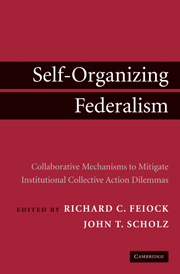 Self-Organizing Federalism
Self-Organizing Federalism Book contents
- Frontmatter
- Contents
- List of Figures
- List of Tables
- Contributors
- Preface
- PART ONE SELF-ORGANIZING VERSUS CENTRALIZED SOLUTIONS TO INSTITUTIONAL COLLECTIVE ACTION PROBLEMS: THEORETICAL CONSIDERATIONS
- PART TWO INTEGRATING METROPOLITAN SERVICE PROVISION: NETWORKS, CONTRACTS, AGREEMENTS, AND SPECIAL DISTRICTS
- 5 Adaptive versus Restrictive Contracts: Can They Resolve Different Risk Problems?
- 6 Do Risk Profiles of Services Alter Contractual Patterns? A Comparison across Multiple Metropolitan Services
- 7 Special Districts versus Contracts: Complements or Substitutes?
- 8 The Political Market for Intergovernmental Cooperation
- PART THREE INTEGRATING REGIONAL POLICIES THROUGH NETWORKS, JOINT VENTURES, AND PARTNERSHIPS
- PART FOUR SELF-ORGANIZING GOVERNANCE AND INSTITUTIONAL COLLECTIVE ACTION
- References
- Index
7 - Special Districts versus Contracts: Complements or Substitutes?
from PART TWO - INTEGRATING METROPOLITAN SERVICE PROVISION: NETWORKS, CONTRACTS, AGREEMENTS, AND SPECIAL DISTRICTS
Published online by Cambridge University Press: 29 January 2010
- Frontmatter
- Contents
- List of Figures
- List of Tables
- Contributors
- Preface
- PART ONE SELF-ORGANIZING VERSUS CENTRALIZED SOLUTIONS TO INSTITUTIONAL COLLECTIVE ACTION PROBLEMS: THEORETICAL CONSIDERATIONS
- PART TWO INTEGRATING METROPOLITAN SERVICE PROVISION: NETWORKS, CONTRACTS, AGREEMENTS, AND SPECIAL DISTRICTS
- 5 Adaptive versus Restrictive Contracts: Can They Resolve Different Risk Problems?
- 6 Do Risk Profiles of Services Alter Contractual Patterns? A Comparison across Multiple Metropolitan Services
- 7 Special Districts versus Contracts: Complements or Substitutes?
- 8 The Political Market for Intergovernmental Cooperation
- PART THREE INTEGRATING REGIONAL POLICIES THROUGH NETWORKS, JOINT VENTURES, AND PARTNERSHIPS
- PART FOUR SELF-ORGANIZING GOVERNANCE AND INSTITUTIONAL COLLECTIVE ACTION
- References
- Index
Summary
Local infrastructure development gives rise to important collective action dilemmas, including scale economies that may not coincide with the scale of existing local governments and negative effects from promoting growth that spill over into neighboring jurisdictions. These dilemmas are amplified in the case of infrastructure for drinking water provision. Securing water supply to meet a community's demands involves competing for access to an increasingly scarce common pool resource. Once a supply source has been identified, the provision of drinking water is capital intensive, with high fixed costs for the construction of storage, treatment, and distribution facilities. These assets are highly specific and cannot be deployed for other local government functions. Thus, local governments can impose substantial costs on their neighbors when making decisions regarding water infrastructure expansion. They also can help their neighbors to achieve growth goals or resolve water scarcity issues by cooperating for drinking water provision.
This chapter focuses on the role of special districts in resolving local coordination problems. Special districts often have been seen as a formalized institution for promoting regional cooperation. They allow boundary design to the scale of public problems and may produce greater efficiency in the marketplace for local public goods. Where fragmentation of local authority has interfered with policy coordination and created gaps in local service provision, a common response has been the creation of a new special district to consolidate authority and promote efficient production of public goods.
- Type
- Chapter
- Information
- Self-Organizing FederalismCollaborative Mechanisms to Mitigate Institutional Collective Action Dilemmas, pp. 142 - 160Publisher: Cambridge University PressPrint publication year: 2009


